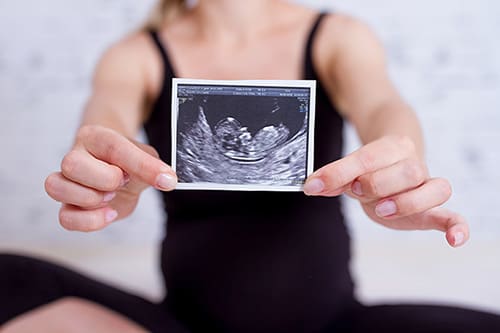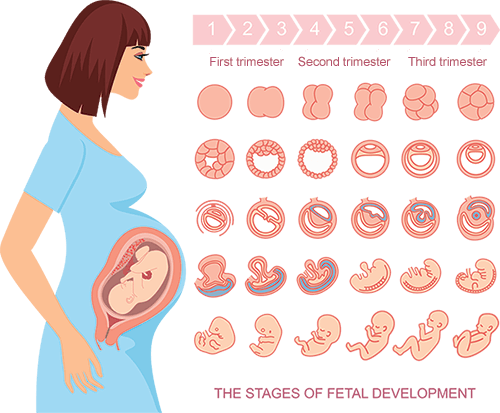
Week 1 and 2: The beginning of the first week is when you will ovulate. In these first two weeks, your egg will be fertilized, and then the fertilized egg will travel down your fallopian tube. The cells of the zygote are multiplying at an amazing rate. You probably will not know you are pregnant during week one or two and will most likely not notice any symptoms, although you may be a little more tired than usual.
Week 3: Now, your zygote is attaching to your uterine wall. It’s organizing into cells in the middle that will become the embryo and cells on the outside that will form the placenta. This is how your baby will receive nourishment throughout the rest of your pregnancy.
Week 4: During week four, the zygote will become an embryo. Typically the embryo will have 46 chromosomes, half from the mother and half from the father. These chromosomes already have the baby’s sex and physical characteristics programmed in. The baby is now in an amniotic sac that will provide oxygen and nourishment for the baby’s growth. This may be the first week you get an idea you might be pregnant as you may miss your period by the end of the week.
Week 5: Your embryo is now going through some very rapid changes. The embryo is now three layers, the ectoderm, the mesoderm, and the endoderm. The ectoderm is the top layer and will form the spinal cord, brain, and nerves from the neural tube, and this layer will also include the hair, tooth enamel, and skin. The mesoderm is responsible for the muscles, bones, and the tiny heart. The endoderm or third layer starts to form the liver, pancreas, lungs, intestines, and urinary system.
Week 6: This is a big week for your embryo. Your baby’s spinal cord and brain are developing rapidly, and her tiny heart starts to beat this week. You can see buds where the arms and legs are forming, and the embryo is in the shape of a “C” right now. Most women begin to suffer from morning sickness when they’re around six weeks pregnant, and it can last for weeks or months.
Week 7: Now, your baby’s arms and legs have gone from buds to paddles as they form. You can also see the nostrils and ears begin to form. Along with these changes, the retinas of his eyes are starting to form. Not only that, but your little one’s brain is developing fast, with brain cells increasing at the rate of about 100 cells per minute.
Week 8: Toes and fingers start to show during week eight, and her face starts to take shape. The top lip, nose, and eyelids are becoming visible, and nerves are spreading throughout the body. The embryo is even making some small movements at this point.
Week 9: Your baby is now about an inch long and is looking like a tiny, tiny baby. If you get an ultrasound now, the embryo will look like a tiny baby…with a huge head! Week 9 also brings about the growth of tooth buds which will start to harden in the following weeks and connect to the jaw bone.
Week 10: Congratulations… at the end of this week, your embryo graduates to a fetus. Your baby is about the size of a walnut. Her organs such as the kidneys, liver, lungs, and intestines have formed and are working.
Week 11: You may not be able to feel it yet, but your fetus is now moving around a lot in there, stretching her arms and legs and kicking. She is even starting to practice swallowing and has grown to the size of a lime.
Check out this video to get a closer look at fetal development week-by-week!
Week 12: Your fetus can now curl her fingers and toes and is starting to make sucking motions. She is also growing fuzzy hair on her body, and her vocal cords are forming along with her taste buds. She has now grown to the size of a small apple.
Week 13: One thing that makes us all unique is our fingerprints, and during week 13, your baby will develop her very own individual fingerprints. The fetus is now about three inches long, and her ribs are developing.
Week 14: Your baby now has expressions. She can frown, squint and even suck her thumb. Her bones are getting harder, and she is developing her sense of taste and smell.
Week 15: In the past couple of weeks, your baby has grown another inch and is now the size of a grapefruit. She has hair follicles developing and is growing hair on her head and eyebrows.
Week 16: Don’t forget to sing and talk to your baby because she can hear sounds now! Week 16 also brings about the possibility of finding out if you are having a boy or girl through an ultrasound. At about five inches from head to butt now, she is growing fast.
Week 17: Can you believe toenails are starting to form on your little one now, and she can move her eyes slowly? She has grown another half inch and is beginning to store the fat she needs to start putting on some weight.
Week 18: This week, you may notice that your baby responds to your movements. When you get up and move around, she may notice and start moving around as well, kicking and doing somersaults. Lanugo, a fine hair, is beginning to cover her skin. She is now about the size of a mango.
Week 19: At this point, vernix, a waxy protective coating, forms on the baby to protect her delicate skin. She is getting more control over her movements and weighs in at about nine ounces. Her height from head to bottom is about six and a half inches now.
Week 20: You are officially halfway there. Your baby is now the size of a small melon, and her fingernails are growing. With an ultrasound, you can see some of her facial features at this point.
Week 21: Weighing in about 12 ounces now, your baby weighs roughly the same as a can of soup. She is about eight and a half inches long, and you may even feel her hiccupping now and then.
Week 22: If you could see your baby now, she would look like a tiny, little, wrinkly baby. Her eyes are fully developed but still fused shut, and her eyebrows are growing in. Her hearing is also improving by the day.
Week 23: By 23 weeks, your baby is growing and is continuing to develop. She can start to hear sounds from outside, and you may feel a reaction to a big noise. She will also be more aware of your movements. You may notice when you are more active, she is more active.

Week 25: Your baby is spending a lot of time sleeping now and is going to start storing needed fat. She is now about the size of a small melon.
Week 26: This week, your baby will start producing melanin that gives her skin color. Her lungs are also beginning to produce surfactant, which will let her lungs inflate when it is time to breathe.
Week 27: Your baby’s eyes now open and close. She can even notice light if you hold a flashlight up against your stomach. She’s also putting on weight now and is probably up to about two pounds. Week 27 marks the end of your second trimester.
Week 28: Your third trimester is here! Your baby’s brain is growing rapidly, now adding billions of nerve cells. From now until your baby is born, her brain will triple in size.
Week 29: Your baby is now working on hardening those bones, so she needs a lot of calcium. From head to toe, she is now about 15 inches long and will weigh approximately two and a half pounds.
Week 30: Now, your baby is starting to produce her own red blood cells that help transport oxygen. The lanugo that began forming at week 18 is now going to start shedding. She is now about the size of a head of lettuce.
Week 31: Your baby will start getting more active and plumping up to get ready for her entrance. She is about 16 inches long now and nearly three and a half pounds.
Week 32: Hair and nails are growing in now, and her bones are getting harder. Her skull will remain somewhat soft and will not completely harden until she is about two years old.
Week 33: Your baby starts looking less wrinkly about now as she starts to store fat. Things are also getting snug in there, so she will be doing fewer somersaults and will be limited to kicking and squirming.
Week 34: Your baby may move to a head-down position this week, getting ready for birth. Her main goal now is putting on weight so that she can maintain body temperature when she is born.
Week 35: Can you believe your baby is probably about five and a half pounds and about 18 ½ inches long. She is growing fast, and you may notice she now has sleeping patterns.
Week 36: This week, your baby is just focused on growing. The lanugo and vernix that were created to protect delicate skin are almost completely gone now, and she prepares for birth.
Week 37: This week, your baby’s brain and lungs continue to develop. She is now about 19 ½ inches long and about six and a half pounds.
Week 38: Your baby’s organs are almost fully developed now, and she is preparing to meet you.
Week 39: You are almost there! Your baby is considered full-term at this point and will be ready to be delivered any time now.
Week 40: This should be the week to greet your newborn. Your baby is ready!
Pregnancy is a journey that every woman experiences in her own way. These are general guides on how a baby develops, but they too experience the journey in their own way.
Becoming a mom is a major life event, and some women feel unable or unequipped to raise a child for a variety of reasons. An unexpected pregnancy can come when a woman doesn’t have the resources to care for a child. Some of these women find adoption to be the best choice for both themselves and their baby.
If you’re thinking about adoption, know that Lifetime Adoption is available 24/7 to provide support and answer your questions. Just call or text Lifetime at 1-800-923-6784.
